Borski in the Backcountry
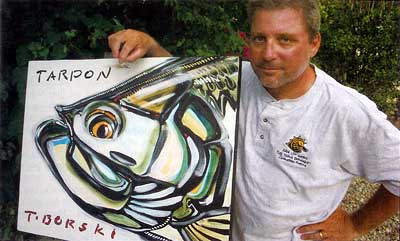
Tim Borski finds inspiration for his impressionistic acrylics, sketches, and watercolors from the species he most often targets with a fly rod. He is also well known in the wildlife-art community for his paintings of Keys birds.
THERE ARE CHEATERS in the no-motor zone today, and Tim Borski doesn’t want to hear their excuses. It’s too damn hot — 90 degrees on an August morning — and he has just spent two sweat-soaked hours getting us to the tarpon.
Starting in Islamorada, we had already blasted 30 miles across Florida Bay with a canoe balanced atop Borski’s skiff, flying out past a sweltering mirage of saltwater Keys and into the plankton-stained sweet water of the Everglades. There we anchored the boat, heaved his canoe overboard, and poled it for a mile toward the farthest green horizon.
Donning full bug suits, we next entered a mangrove creek and paddled for another half mile enveloped in cobwebs, banana spiders, and the electric hum of mosquitoes, both of us sucking up so much bug dope that it might as well come in an asthma inhaler. But at last the creek revealed a lake and, by grace, a score of happy tarpon dimpling its smoked-glass surface. That’s when we heard the motor.
“Please tell me it’s a park ranger,” says Borski, quietly poling toward the blooping fish.
Instead, a johnboat sputters around the point bearing two plug-chunking “googans” with no more sense than to skid to a stop right on top of the silverscaled motherload.
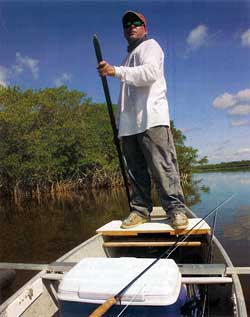
Poling the no-motor zones of the Everglades is Tim Borski's forte. His canoe rides atop a small skiff to the edge of the zone and then is reassembled for a wilderness fishing experience.
“Are you guys cops?” Borski asks, hotter than a mangrove cuckoo.
“Huh?”
“Are you guys cops? Cause if you’re not rangers, you aren’t allowed back here.”
“It’s six horsepower from West Lake,” says the throttle man.
“No motors!” Borski insists, then begins reciting their boat registration. “Remember that, Steve. F… 1… 2… 5….”
Frankly, I’m as lost as an Eskimo in a coal mine. But I do know that if I motored up on someone poling the swampy hinterland in a freaky-deaky canoe, looking like a bandit with that gray neck gaiter pulled up around his eyeballs, as if to trap more of the godforsaken heat, I probably wouldn’t argue local geography with that person.
After several tense exchanges, the intruders crank up and move deeper into inviolate waters, though not without a nice little prop chewing from Borski, who’s normally quite jovial. But with his reputation as an angler, artist, and conservationist carved out of this very wilderness, well, “no motors” means No Motors!
“They’ll ruin it for those of us who are willing to put in the effort,” he says, literally steaming as we ease away from the tarpon. “I mean, hell, it’s August. There’s not supposed to be anyone back here,” he says. “Except me.”
Life Borski’s Way
There was a time when Tim Borski was the last person you’d find prowling the remote Florida backcountry: As a kid growing up in central Wisconsin, he knew next to nothing about saltwater fishing, let alone fly fishing. But two decades after a chronic case of frostbite drove him south, Borski’s distinctive wildlife art and highly effective saltwater fly patterns are synonymous with Florida fly fishing, particularly the no-motor zones of the Everglades.
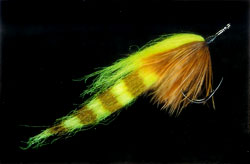
Green Zima
Borski’s contemporary paintings are collected by anglers and birding enthusiasts, and they are displayed in galleries from Key West to Japan. His prints and T-shirts are sold at select fly shops nationwide, and in 2006, Patagonia will release two new Borski Ts to support its Oceans as Wilderness Initiative. Five dollars from the sale of each shirt will go to the conservation group Bonefish and Tarpon Unlimited, of which Borski is a founding member.
The once winter-weary Polish kid who grew up chasing Wisconsin smallmouths with casting tackle now gives talks on saltwater fly fishing at the International Game Fish Association and other venues. He fishes as a “celebrity” on the Redbone circuit and at the tony Ocean Reef Club in Key Largo. His recently released instructional DVD series, “Borski Ties Flies,” is the fitting oeuvre of a passionate fly tier and hardcore backcountry angler, whose personal story is as colorful as his paintings.
Back in 1983, Tim Borski was living in Stevens Point, Wisconsin, working full time in a factory and pursuing a bachelor’s degree in fine arts. “It was the first sunny day after a long, long winter,” he recalls. “I’d been down to the Wisconsin River that day and just crushed the smallies.”
With visions of a repeat performance, he went home and greased up his Mitchell 306. Rising early the next morning, he coughed an excuse into the phone at his boss and grabbed his tackle. “Then I swung open the door, and there was nine inches of fresh snow on the ground,” he says. “I freakin’ snapped. ”
That same morning, Borski withdrew all his money from the bank. He called a friend to ask if he would watch over his cabin, telling him, “I’m flying to Florida tomorrow, and I’m either going to catch a bonefish or go broke trying.”
At age 23, Borski arrived in Miami with about $1,500 — part of that a student loan. He had no more knowledge of bonefishing than what he’d read in magazines. But by a stroke of luck, he was able to engage the services of Bill Curtis, a pioneering Biscayne Bay guide who is now generally regarded as the originator of the poling platform. At the end of a long day (which included Curtis repeatedly snatching Borski’s sunglasses off his nose and yelling, “Are those things polarized?”), Borski finally landed a bonefish on a spinning rod. Regardless of having chummed it up with shrimp, he was ecstatic.
On the way back to his hotel, Borski stopped to get a six-pack. Walking back to his car in the parking lot, he pulled out his return ticket, took a good last look, and then ripped it up and threw it in the Dumpster. Tim got a job the next day at a local toy store. Three days later, he went to work for a Miami arts-and-crafts shop, where his boss happened to be married to Frank Oblak, a renowned light-tackle angler and fly tier. It was Oblak who first pointed Borski toward the Keys.
“I started going down to the Seven Mile bridge to camp out and fish for tarpon with jigs. I became a tarpon junkie,” says Borski, who began working 15-hour days so he could take four days off per week to fish. The art store also sold him discounted paints and supplies so he could continue painting.
When Tim expressed an interest in fly fishing, Oblak, who had thrown his back out fighting a huge tarpon, sold the young angler his personal tying vise. Borski also bought a cheap fly rod, and he taught himself to cast by taking target practice at the burrowing owls that bordered a nearby Miami soccer field. His notion was to catch one bonefish on a fly — just so he could say that he’d done it — and then sell the whole outfit to get his money back. But when that dream became a reality one spring day out on Sunshine Key, the notion quickly became an obsession.
Turning Pro
Borski soon came up with his first commercial fly: a bonefish pattern featuring a grizzly-hackle tail and named, with classic Borski humor, Captain Korn’s Grizzly Boner. In order to pursue his art and his angling without interruption, he took a job as a caretaker on Craig Key, a private island.
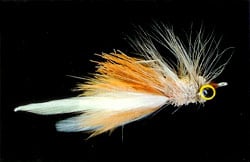
Chernobyl Crab
“I told myself I’d take six months to paint and tie flies, and if I didn’t lose more than six pounds, I’d give myself six more months,” says Borski. He painted, fished, and occasionally mowed the lawn in his “underwear, cowboy boots, and big yellow cowboy hat.”
That six-in-six regimen kept him on Craig Key for more than a decade (beer is fattening), where he developed his now widely recognized style as a painter and a tier. Some of his more popular patterns include the Chernobyl Crab, Bonefish Slider, Critter Crab, Bonefish Critter, Craft Fur Shrimp, Swimming Shrimp, and Green Zima. Many of Borski’s flies are now sold by Orvis, Bass Pro Shops, Cabela’s, and “a zillion” fly shops.
“He’s one of the most innovative saltwater tiers down there, especially on bonefish and permit, but also tarpon and snook,” says fly-fishing pioneer Chico Fernandez. “His patterns catch fish, and they become patterns that everybody fishes, or that everybody makes variations of.”
It’s as easy to spot a Borski fly as a Borski painting. Simple to tie and typically designed to push water, they have a “bugginess” that is absent in many saltwater patterns. And you won’t find much realism in either his paintings or his flies, both of which can be best described as impressionistic.
“I tie my flies to imitate a little bit of a lot of different things,” says Borski, attributing this to pragmatism as much as tying philosophy. “My life is too complicated now to spend a lot of time making each fly look pretty. It takes ten hours of tying a week just to supply myself with flies.”
He does not use much flash, and most of his patterns rely on natural colors. “I don’t use anything more than it takes to get the job done,” he says, emphasizing that his flies are only tools. “The angler has a job to do before one of my flies ever hits the water, such as making sure the weed guard is straight, that the tail is not fouled, or squeezing out the air bubbles. ”
A fully saturated fly moves better in the water, and Borski designs many of his flies to achieve maximum movement with a minimal amount of manipulation — often with just the rod tip. “I want that fly to sit there and wiggle in the strike zone as long as possible,” he says. This is particularly effective for fishing the ragged edges of the no -motor zone, where casts are short and quick as you pick apart tarpon and snook “houses” in the shady pockets of the mangroves.
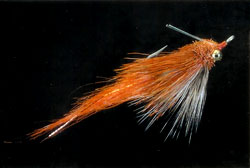
Redfish Slider
Borski also emphasizes materials selection, whether it’s the longest schlappen, the richest winter-harvested rabbit pelts, or the plushest Wisconsin deer hides with wide, hollow fibers. “Your fly is only as good as the materials you use. I never buy anything sight unseen, except for things like eyes, and hooks, and flash,” he says. “And when I do find good material, I’ll try to buy the whole rack, even if I don’t know what I’m going to tie with it.”
Last year, Tim began detailing his patterns in the first two releases of “Borski Ties Flies.” Each DVD offers clear and concise tying steps for five Borski originals, followed by footage of the fly in action. From bonefish on the flats to tarpon in the no-motor zone, the action is as good as anything you will see on Saturday morning television.
Unfortunately, capturing footage of a 30-pound tarpon going ballistic off the bow of a canoe is extremely hard work. Borski and his production partner, Capt. Jon Milchman, spent more than 100 days on the water shooting material for the first video. And with his artwork to keep him busy, he says the last three installments of the planned five-part series will have to wait.
“It got to be not very fun,” he says. “One day we went out and caught fourteen snook but no jumpers. We had a great day, and yet we were disappointed. There is something wrong with that.”
He doesn’t rule out producing another installment, but for now he is content stalking the backcountry for fun and inspiration rather than photo ops. He does, however, worry about the future of that Everglades no-motor experience, where sweat and effort is the price of admission.
“If people don’t respect the rules, the park service could decide that they just want to shut some areas down altogether,” he says. “That would certainly make my world a whole lot smaller.”











